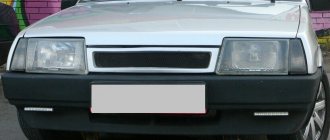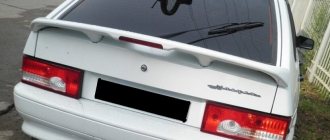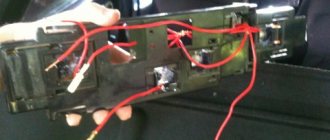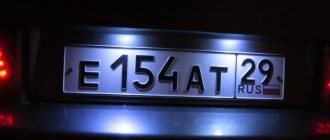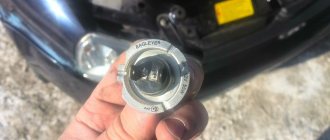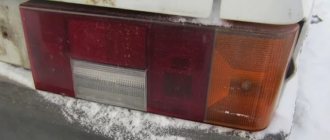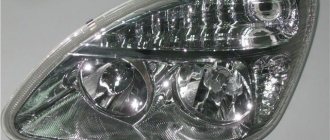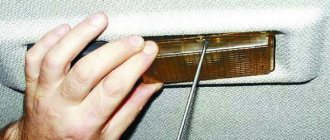What kind of light bulbs are in the PTF VAZ 2112?
Lamps used in Lada 112 hatchback VAZ-2112 cars
| Light device | Quantity, pcs | Lamp type |
| Front marker light | 2 | W5W |
| Front direction indicators | 2 | PY21W |
| Front fog lights (depending on configuration) | 2 | H3 or H1 |
| Side direction indicators (depending on configuration) | 2 | W5W or WY5W (yellow bulb) |
Recommendations for selection
I hope the installation issue has been sorted out. If you decide to install LED lamps in halogen headlights, it is entirely at your own peril and risk.
I advise you to act within the law, otherwise you will get tired of constant conversations with traffic police officers, fines and other proceedings.
If you can install LEDs, all that remains is to answer the question of which ones are better.
I can’t say for sure which company’s products are best to buy. From personal experience, I tried lamps from Philips. I was pleased and still use it. But if you want, look for alternative solutions. Much also depends on what kind of lens and base you need.
LEDs are classified depending on the type of base. They are divided into:
- H1;
- H3;
- H4;
- H7;
- H8;
- H9;
- H11;
- HB2;
- HB3;
- HB4.
I propose to consider the main positions, dividing the choice of LEDs into several categories.
Namely:
- low beam;
- further;
- near/far;
- fog lights;
- dimensions.
We will study each of the points separately.
Low beam
For low beam headlights, the H7 base is mainly used. H11 is used a little less often. The LEDs are located in the upper part, the light stream is reflected downwards from the headlight reflector.
For low beam it is recommended to use LED with:
- power from 12 W;
- light flux from 1000 lm;
- radiator in the design.
When purchasing LEDs for such purposes, you need to consider several important nuances. So that LED installation does not become an unpleasant surprise for you.
We are talking about the following pitfalls:
- Due to the size of the radiator, LEDs sometimes make it difficult to put on the sealing cap for car headlights;
- the design of the headlight does not always correspond to the design of the LED, which makes the light boundaries insufficiently clear;
- The power is 3 times lower compared to halogen, so LEDs cannot always protect the optics from icing in winter (little heat is generated).
Let's move on.
High beam
The H1 base is used here, which imposes more power requirements. The prices for LED high beam headlights vary widely. But here quality is closely related to cost.
There is a lot of controversy and talk regarding LED-based high beams. Moreover, the majority considers this not the most correct decision.
The minimum characteristics should be:
- power from 17-20 W;
- luminous flux from 1500 lm;
- presence of a radiator.
The disadvantages are similar to low beam headlights. As practice shows, it is better to leave high beams based on halogen. There's too much risk of not getting what you wanted.
Near/far
LEDs on the H4 socket are different in that a pair of powerful LEDs are combined in one lamp. The low beam is located at the top, and the diode responsible for the high beam is at the bottom.
When choosing such a design, it is better to give preference to more compact models. The headlights of the car were originally adapted for spiral halogens. Therefore, for diodes, their dimensions should correspond as much as possible to the dimensions of the spirals.
The performance requirements are:
- for long-range illumination, luminous flux from 1500 lm;
- for the neighbor at least 1000 lm;
- total power of at least 17 W with an efficiency of 100 Lumens per Watt;
- the presence of an active or passive cooling radiator.
Please note that manufacturers often indicate the total brightness. It’s also not worth buying too bright ones, since this is more of a marketing ploy than a real benefit.
Fog lights
Most often, motorists change halogens to LEDs in PTFs, using base H11 and H8. They do not perform a primary role, so traffic police officers have a minimum of questions about them.
But due to the wrong approach, many choose 400-700 lm light bulbs. In the end, it turns out that halogens worked much better.
To ensure that the LEDs in PTF do not disappoint you, choose a brightness of at least 900-1000 lm. The less powerful ones become meaningless and useless.
A few years ago, mass production of special diodes with a yellow cap and position adjustment began. This allows you to make them into a full-fledged imitation of a halogen lamp. With such optics, traffic police officers will definitely not be able to find fault.
parking lights
The base used here is W5W T10. Marking T10 T5 is also found. The assortment is huge, which is somewhat confusing for car owners.
Nominally the power should be 5 W, and the brightness should be from 50 lm. There is no point in increasing these parameters excessively. The more powerful the LEDs, the faster they fail. This is due to overheating.
Most motorists prefer devices with 1-2 watts and 50-100 lm.
Whether to install diodes or not is a purely personal decision.
I just want to suggest when it’s not worth doing this, and in what situations there are no real obstacles.
Thank you all for your attention! Subscribe, leave comments, ask questions!
How to turn on the high beam headlights on a VAZ 2110?
To signal with high beam headlights, pull the left steering column switch towards you without bringing it to a fixed position. The high beam remains on when the lever is held, and when released, the lever returns to its initial position.
Interesting materials:
How to call a dog catcher? How to call a helicopter in Far Cry 5? How to froth coffee at home? How to get your login and password from a Rosselkhozbank ATM? How to get a statement from a Qiwi wallet? How to train an adult cat to use a litter box? How to weigh flour without scales? How to get to Zandalar as an alliance? How to bind the camera in Dota 2? How to block an IP address on a computer?
Restoring the backlight and changing the warning lamps
We remove the light bulb that needs to be replaced (the purpose of the light bulbs is in the first photo of the article). To do this, turn the socket counterclockwise 90 degrees, and it will easily come out along with the light bulb.
Replacing a light bulb without disconnecting the power wires on a VAZ 2110
We remove the burnt device from the socket, insert a new one in its place and install the socket with the lamp in place, turning it 90 degrees, but clockwise. After this, we install the terminal on the battery, turn on the ignition and check the operation of the VAZ panel, performing the appropriate manipulations: turn on the hand parking brake, headlights, turn indicators, high beam headlights, etc. If everything is in order, then install the panel and decorative trim in place .
I replaced the lamps, but there is still no backlight - possible reasons
It may happen that the lighting or indication on the VAZ will not be restored even after replacing the lamps. What is the problem and how to find and fix it? Let's look at the main reasons for this situation, and the easiest way to search is in the order in which they are listed:
- The power and control cable connectors have oxidized.
- The contact pads of one or a group of lamps have oxidized.
- The fuse that powers the backlight bulbs has blown.
- The conductive paths have oxidized and become short-circuited or “burnt out.”
- The wires supplying certain lamps are short-circuited to the car body.
Types of lighting
To ensure reliable and long-term operation of headlights, car owners can choose from LED, xenon, halogen or conventional incandescent lamps for close beam
The following types of lamps are popular among owners of the VAZ 2110 and 2111 models:
- Philips Vision. Capable of providing one third more light than halogen models. They are also significantly superior in quality and durability to the factory lighting of many car models. Often these particular lamps are installed in machine production, which is an indicator of the highest quality of the model. In terms of price-quality ratio, they are considered one of the best options for VAZ;
Philips Vision bulbs
- Philips VisionPlus. The model is a modernized Philips Vision type. It illuminates the road surface 60% better than a standard halogen model, which provides enormous light output;
Philips Vision Plus light bulb
- Philips X-treme Vision. It is the most massive lighting component, as it helps increase the luminous flux by 100%. It is not installed during the production of the VAZ, so it must be taken separately;
Philips X-treme Vision bulbs
- Osram Night Breaker Plus. With them the light is 90% brighter. In addition, the glow of the product is 10% whiter than ordinary models. This allows you to significantly (up to 35 meters) increase the length of the illuminated road surface. Also, the products last 50% longer than conventional halogen varieties;
Osram Night Breaker Plus Bulbs
- Philips Diamond Vision 5000 K. Capable of increasing the brightness of light by 20% relative to the standard lighting in Veil 2110. The low beam in the headlights when using such products becomes very close to natural light in the daytime. They are more expensive than most of the presented models;
Philips DiamondVision light bulbs
- Osram CoolBlue 5000 K. The highest color temperature provides colorful snow-white (but close to daylight) lighting, which at the same time does not tire the driver and is easy on the eyes.
Osram Cool Blue Bulbs
Is it possible to install halogen lamps in cars? Note to motorists
According to statistics, more than 60% of accidents occur in the dark, and poor lighting is to blame. Despite this, about a third of motorists still ignore the problem, continuing to drive with obsolete vacuum incandescent lamps. Many car owners are concerned about whether it is possible to install powerful halogen lamps, which ones are better, and whether there are pitfalls for this modern type of lighting when applied to car headlights. Let's try to figure it out.
This is what light looks like from a regular incandescent lamp and from a halogen lamp
Obvious advantages of halogen lamps
Ultra-bright lighting - they fulfill their main purpose one hundred percent!
Long service life - about a thousand hours under normal operating conditions.
A wide range of types, sizes and sockets, which includes products for almost any car from BMW to Hummer and any type of headlights - both transparent and darkened or painted in various colors.
Relatively low cost - they are 3-4 times cheaper than the closest “competitor” xenon.
Why do some motorists hesitate?
There really are nuances. In some modifications, a significant amount of energy is wasted, despite the fact that the light output always remains at a decent level
Another point is the need for careful handling of such products, because they can be destroyed by interaction with seemingly “harmless” substances around us
Is everything really that scary? Not at all. For example, in order not to damage the light bulb with harmful skin oils, you should replace it with gloves or touch the surface only with a napkin. As for efficiency, this problem has been successfully solved in new generations of halogen-based lighting devices, the efficiency of which has increased significantly. The bulb in them is covered with a special coating that reflects infrared radiation. The latter no longer evaporates aimlessly, but returns to the spiral and is converted into useful light energy.
Halogen headlights are sensitive to hand touch, so you need to wear gloves when replacing them.
Halogen or xenon?
Unlike a halogen lamp, xenon products, also popular today, actually provide even more powerful light, and last 2-3 times longer due to the absence of a fragile thread inside. But this medal also has its negative obverses, and the high price is not the only drawback.
Manufacturers often keep silent about the fact that after two hundred hours of constant operation, the luminescence spectrum in them becomes much more faded. To connect to the electrical circuit, an additional “ignition unit” may be required: otherwise, there is a high probability of a flickering effect, so there is no question of any comfort while driving. And too bright does not mean “good”: xenon light often blinds oncoming drivers for a few seconds, which can be fatal on a night road.
What to choose, each owner of a Mercedes, Mercury or other car decides for himself. On the one hand, there are powerful, super-bright and incredibly expensive (and you always have to change them in pairs!) xenon bulbs. On the other hand, no less bright, but durable, and most importantly, affordable halogen-based products. For any make of car, for any design and for any budget!
Causes of malfunction
There may be several reasons why the lighting does not work. Each malfunction requires an individual approach and implies its own troubleshooting methods. Causes of the malfunction and methods for eliminating them (if some lamps of flashlights and headlights do not work):
- burnt fuses - replace them (see);
- lamp filaments are burnt out - change the lamps;
- contacts on relays or switches have oxidized - clean them;
- the wires are damaged, their tips are oxidized or the connections are loose - replace the faulty wires, clean the tips;
- The contact jumpers at the location of the lamp control relay have oxidized - clean them.
Sometimes the headlight lens fogs up a lot. What are the reasons and what to do in this case:
- leaky adhesion of the lens to the body - immerse the headlight unit in water, if liquid penetrates, replace the headlight;
- moisture enters in the direction from the engine compartment during the process of washing the car - eliminate the liquid from the headlight unit.
Tuning taillights - main options
Tuning tail lights on a VAZ is most often:
- painting rear lights;
- use of tint film;
- installation of LEDs.
The surface is covered with glossy or matte vinyl film. It can be applied completely, partially in a certain place on the glass and removed at any time. Tinting material is produced in different colors and shades. The film has a protective function and can be used to protect the element from mechanical impacts of small stones.
The film is applied to the outer surface of the headlight in stages:
- Wash and dry the headlight unit.
- Wet the surface with soapy water.
- Cut the film to the required size.
- Remove the backing and apply it to the surface of the lampshade.
- Carefully smooth out from the center to the edges.
- Dry with a hairdryer.
- Remove excess film.
Varnish or paint is an economical option, but not always effective if you apply it yourself. To use, you need to wash and dry the lanterns well, then degrease and varnish.
Tinting should not reduce the brightness of lights by more than 15%. Although the traffic rules do not contain clear instructions on tuning rear optics, questions from the inspector may arise.
Tuning LED headlights have increased brightness and clearly define the dimensions of the car. More often, diode strips are used, which are installed around the perimeter of the rear stop.
Using LEDs
To tune the rear lights of the VAZ 2110, installing LEDs and painting the lampshade are most often used. LEDs are mounted in plastic reflectors after dismantling the headlight unit. For the VAZ 2110 it is recommended to choose two colors: red and yellow. The tapes are soldered and placed on the base inside the headlight unit.
To make the light as bright as possible, the base of the headlight is painted black. Tuning procedure step by step.
- Dismantle the headlight, remove the glass, remove the lamps.
- Fill the inside of the block with a thin layer of polyurethane foam.
- Give the foam the desired shape by determining the areas for installing the LED strip.
- Glue the LEDs onto the base inside the headlight.
- Install glass, connect wiring.
When installing LEDs at 6 Volt dimensions, stops and turns at 12 Volt, capacitors are installed, this prevents overheating of the optics.
LED characteristics
Modern single LEDs, matrix blocks, diode strips produced by well-known companies are distinguished by their high service life and reliability. Technical characteristics of LED blocks:
- service life more than 4000 hours;
- operate at minimum on-board voltage;
- good light data;
- no overheating occurs;
- are not subject to vibration and mechanical effects;
- variety of colors.
The luminous flux of such lamps does not dazzle the eyes and is visible from a great distance. Availability allows for inexpensive and high-quality repairs.
DIY LED tuning of rear lights
To perform LED tuning of rear lights you will need a minimum set of tools and an LED strip of the required length.
Do-it-yourself tuning of rear lights on a VAZ 2110 step by step:
- Disassemble the headlight.
- Pull out the diffuser.
- Paint the reflectors black.
- Prepare the site and glue the LEDs.
- Solder stabilizers and wires from old lamps to the tape.
- Place the reflector on top of the diodes.
- Assemble the tuned spotlights and install in the reverse order.
LED pinout
Before connecting the wires, you need to pinout the LEDs. To make them glow, you need to pass an electric current through them in the direction from the anode to the cathode. To do this, a positive charge must be applied to the anode, and a minus charge must be directed to the cathode.
It is recommended to check the LED strip before installing it on the car.
